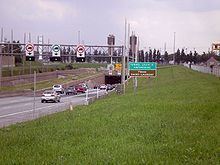Height {?} Clearance below 8 m (26.2 ft) (?) Total length 1,391 m Province Québec | Crosses Saint Lawrence River Clearance above 4.4 m (14 ft 5 ⁄4 in) Opened 11 March 1967 Width 37 m | |
 | ||
Named for Louis-Hippolyte La Fontaine Similar Jacques Cartier Bridge, Victoria Bridge, Champlain Bridge, Honoré Mercier Bridge, Charron Island | ||
The Louis-Hippolyte Lafontaine Bridge–Tunnel (Pont-Tunnel Louis-Hippolyte-La Fontaine) is a Canadian highway bridge–tunnel running over and beneath the Saint Lawrence River. It connects the Island of Montreal with the south shore of the river at Longueuil, Quebec.
Contents
Map of Tunnel Louis-Hippolyte-La Fontaine, Qu%C3%A9bec, Canada
Construction began in 1963 and it opened on March 11, 1967. Named for the respected Lower Canada political reformer Louis-Hippolyte Lafontaine, the Lafontaine Tunnel is an immersed tube structure, measuring 1,391 m (4,563.6 ft) long. It carries the Autoroute 25 expressway and passes beneath the main shipping channel in the Saint. Lawrence River immediately downstream from the Saint Lawrence Seaway. It surfaces on Île Charron (Îles de Boucherville at entrance/exit #1 of Autoroute 25), then continues by bridge to Longueuil.
Each section weighs 32,000 t (31,000 long tons; 35,000 short tons), is 110 metres (360 ft) long, 37 metres (121 ft) wide and rises to a height of 8 metres (26 ft). In total, the bridge–tunnel is 1.8 kilometres (1.1 mi) long. It is estimated that 44 million vehicles drive through it per year, or 120,000 per day. The tunnel was built with sections prefabricated in dry dock and then sunk in the river, 24 metres (79 ft) below the surface of the water. It is one of the largest prestressed concrete structures in the world.
History
In 1960, the construction of the Trans-Canada Highway (TCH) through Quebec from the Ontario border to Rivière-du-Loup was announced. In Montreal, to avoid having to build a huge bridge that would have disfigured the city and destroyed a neighbourhood, the engineers opted for the construction of a tunnel located under the Saint Lawrence River, and dug a trench under the river bed and buried the tunnel sections 4.6 metres (15 ft) to 6.1 metres (20 ft) under the river bed. The construction was completed in March 1967, just before the opening of Expo 67. Construction cost $75 million.
It bears the name of Louis-Hippolyte La Fontaine, a politician born in 1807 in Boucherville.
